Home | Category: Old and Middle Kingdom (Age of the Pyramids) / Art and Architecture
PYRAMIDS OF ANCIENT EGYPT
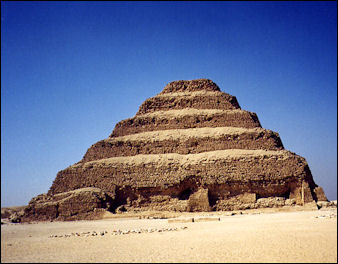
Stepped pyramid at Saqqara Pyramid are royal tombs. Located nearby was a mortuary temple and a valley temple where the king's body was ritually prepared before it was carried on a desert causeway to the pyramid. Even though the pyramids were believed to have been erected for the dead a grave or a royal mummy has never been found inside one. Positioned near the pyramids were “ mastabas” of his nobles.
Dr Joyce Tyldesley of the University of Manchester wrote for the BBC: “Egypt's pyramids served as tombs for her dead kings. The focus of a complex of ritual buildings, the pyramid was the magical powerhouse where the mummified pharaoh would attain eternal life. The first pyramid was Djoser's Step Pyramid, built not long after Egypt had become a unified land. The Great Pyramid of Khufu, at Giza, was raised a century later.” [Source: Dr Joyce Tyldesley, University of Manchester, BBC, February 17, 2011|::|]
Altogether 106 known pyramids (most of them now ruined) were built in Egypt between 2700 and 2200 B.C. All but twelve of them were built for men. The only other ancient structure that is comparable in term of size is the Great Wall of China. Not all pyramids were big though. The pyramid built by Khufu’s son Djedefre measured only 35 feet on each side.
"Pyramid" is Greek for "wheaten cake," a word coined perhaps because the Greeks thought the pyramids looked like cakes sitting on the desert ("obelisk" is a Greek word that means "skewer" which also suggests that maybe the Greeks didn't get enough to eat when they were in Egypt). The Egyptian word for tomb was a "castle of eternity" and their word for pyramid may have meant "place of accession." The Step Pyramid of Djoser was described as a "staircase to heaven" which the pharaoh "may mount up to heaven thereby." [Source: Daniel Boorstin, "The Creators"]
Large amounts of government money was diverted to build the pyramids and royal tombs. The Pyramids were reserved for royals. The large priest and noblemen class built elaborate house-like stone tombs with detailed stone engravings and hieroglyphics. Traditionally the pharaoh ordered work on his pyramid to begin almost immediately after he took the throne. Work often was completed or wrapped up soon after he died.
It is believed that royal mummies were placed in the pyramid tombs although none have ever been found. Items that have been found in Old Kingdom noblemen tombs include papyrus writing material and things made from gold and lapis lazuli.
Categories with related articles in this website: Ancient Egyptian History (32 articles) factsanddetails.com; Ancient Egyptian Religion (24 articles) factsanddetails.com; Ancient Egyptian Life and Culture (36 articles) factsanddetails.com; Ancient Egyptian Government, Infrastructure and Economics (24 articles) factsanddetails.com
Websites on Ancient Egypt: UCLA Encyclopedia of Egyptology, escholarship.org ; Internet Ancient History Sourcebook: Egypt sourcebooks.fordham.edu ; Discovering Egypt discoveringegypt.com; BBC History: Egyptians bbc.co.uk/history/ancient/egyptians ; Ancient History Encyclopedia on Egypt ancient.eu/egypt; Digital Egypt for Universities. Scholarly treatment with broad coverage and cross references (internal and external). Artifacts used extensively to illustrate topics. ucl.ac.uk/museums-static/digitalegypt ; British Museum: Ancient Egypt ancientegypt.co.uk; Egypt’s Golden Empire pbs.org/empires/egypt; Metropolitan Museum of Art www.metmuseum.org ; Oriental Institute Ancient Egypt (Egypt and Sudan) Projects ; Egyptian Antiquities at the Louvre in Paris louvre.fr/en/departments/egyptian-antiquities; KMT: A Modern Journal of Ancient Egypt kmtjournal.com; Ancient Egypt Magazine ancientegyptmagazine.co.uk; Egypt Exploration Society ees.ac.uk ; Amarna Project amarnaproject.com; Egyptian Study Society, Denver egyptianstudysociety.com; The Ancient Egypt Site ancient-egypt.org; Abzu: Guide to Resources for the Study of the Ancient Near East etana.org; Egyptology Resources fitzmuseum.cam.ac.uk
Books: “ Pyramid “ by David Macaulay (Lorraine Books, Houghtin Mifflin Company); “ Building the Great Pyramid” by Kevin Jackson and Jonathan Stamp
Seven Wonders of the World
The pyramids are the only one of the seven wonders to survive. The others vanished after they were toppled by earthquakes and/or scavenged for building material. The images that we have of the seven wonders today are primarily paintings and drawing made by medieval and Renaissance artists over a thousand years after the wonders were gone.
The Seven Wonders of the World were first mentioned in the 2nd century B.C. by a man called Antipater of Sidon. They are: 1) the Pyramids of Giza (Egypt); 2) Hanging Gardens of Babylon (Iraq); 3) the Tomb of King Mausolus (Turkey); 4) Temple of Diana (Turkey); 5) Colossus of Rhodes (Greece); 6) Statue of Olympia (Greece); 7) The Pharos of Alexandria (Egypt).
Pyramids as Mortuary Temples for the Pharaohs
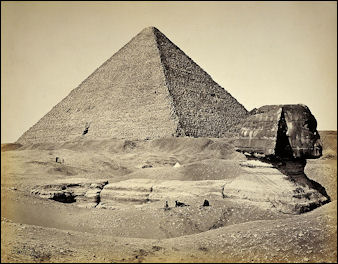 Large amounts of government resources were diverted to build the pyramids and the royal tombs. The Pyramids were reserved for royals. The large priest and noblemen class built elaborate house-like stone tombs with detailed stone engravings and hieroglyphics.
Large amounts of government resources were diverted to build the pyramids and the royal tombs. The Pyramids were reserved for royals. The large priest and noblemen class built elaborate house-like stone tombs with detailed stone engravings and hieroglyphics.
According to PBS: “Each pyramid has a mortuary temple and a valley temple linked by long causeways that were roofed and walled. Alongside Khufu and Khafre's pyramids were large boat-shaped pits and buried boats that were presumably meant to aid the pharaoh's journey to the afterlife.... In addition, cemeteries of royal attendants and relatives surround the three pyramids. The entire plateau is dotted with these tombs, called mastabas, which were built in rectangular bench-like shapes above deep burial shafts.”
The pyramid were manifestations of the Egyptians' beliefs in the afterlife..Early pre-pyramid royal tombs were essentially made up of an underground burial complex in one location-with a large rectangular enclosure a kilometer or so away, where ceremonies for the dead were carried out. The first pyramid, Djoser’s Step Pyramid, which in many ways combined the old separate elements in one location. [Source: Dr Aidan Dodson, a Visiting Fellow in the Department of Archaeology at the University of Bristol, where he teaches Egyptology, BBC, February 17, 2011 |::|]
Dr Aidan Dodson wrote for BBC: It is important to realise that the actual pyramid was only one part of the overall magical machine that transferred the dead king between the two worlds of the living and the dead. The pyramid complex began on the edge of the desert, where the Valley Building-now lost under a Cairo suburb-formed a monumental portal. |::|
“From here, the burial cortege, priests and visitors would pass through ceremonial halls onto a causeway that ascended the desert escarpment to the mortuary temple, built against the east face of the pyramid. Here, behind a great colonnaded courtyard, lay the sanctuary in which offerings were made to the king's spirit. Either side of the mortuary temple lay a buried boat-perhaps a souvenir of a funeral flotilla, or put there to allow the king to voyage in the heavens-and to the south was a miniature pyramid. Such so-called subsidiary pyramids are of uncertain purpose: they are generally classified as 'ritual'-archaeologists' code for 'obviously important to the ancient people, but we have absolutely no idea why'. |::|
“An offering place was one of the two immutable parts of an Egyptian tomb. The other was the burial place. In the Great Pyramid-and in most other pyramids-this was reached from a narrow, low, opening in the north face. The interior of the Great Pyramid is complex, almost certainly resulting from a number of changes of plan. |::|
“The Great Pyramid was the hub of a huge complex of cemeteries intended for members of the royal court. To the east, three of the king's wives had their own small pyramids, with streets of mastaba-bench-shaped tombs-for his sons and daughters. West of Khufu's pyramid was an even larger cemetery for the great officials of state. All these tombs had been laid out to a single design, a unified architectural conception of the king surrounded by his court, in death as in life. It is a concept that has been without direct parallel before or since.” |::|
Burial Chambers of the Pyramids
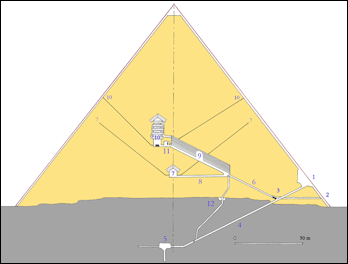
Cheops Pyramid Interior On what is inside the Great Pyramid in Giza, Dr Aidan Dodson wrote for BBC:“At first, the burial chamber was to be placed deep underground, with a descending passage and an initial room being carved out of the living rock. It seems, however, that it was decided that a stone sarcophagus-not previously used for kings-should be installed. Such an item would not pass down the descending corridor, and since the pyramid had already risen some distance above its foundations, the only solution was to place a new burial chamber-uniquely-high up in the superstructure, where the sarcophagus could be installed before the chamber walls were built. The architects of later pyramids ensured that there was adequate access to underground chambers by using cut-and-cover techniques rather than tunnelling. [Source: Dr Aidan Dodson, BBC, February 17, 2011 |::|]
“Two successive intended burial chambers were constructed in the body of the pyramid, the final one lying at the end of an impressive corbel-roofed passage, which seems originally to have been intended simply as a storage-place for the plug-blocks of stone that were made to slide down to block access to the upper chambers after the burial. Corbel-roofing, where each course of the wall blocks are set a little further in than the previous one, allowed passages to be rather wider than would have been felt to be safe with flat ceilings, and are a distinctive feature of the earliest pyramids and tombs of the Fourth Dynasty, to which Khufu belonged. |::|
“The burial took place in that final burial chamber, nowadays dubbed the King's Chamber. An impressive piece of architecture, this granite room was surmounted by a series of 'relieving' chambers that were intended to reduce the weight of masonry pressing down on the ceiling of the burial chamber itself. At the west end of the chamber lay the sarcophagus, now lidless and mutilated. |::|
“It is unclear when the pyramid was first robbed, although some Arab accounts suggest that human remains were found in the sarcophagus early in the ninth century AD. As for what else may have been in the chamber when Khufu was laid to rest, there will have been a canopic chest for his embalmed internal organs, together with furniture and similar items. Examples of such simple, but exquisite, gold-encased items were found in the nearby tomb of Khufu's mother in 1925. |::|
“So-called airshafts, only 20cm (8in) square, leave the north and south walls of the chamber and emerge high up on the corresponding faces of the pyramid. These also were found in the original high-level burial chamber, and seem to have been aimed at particular stars, implying a stellar aspect to the king's afterlife-although as we have seen he was later more closely associated with the sun. Interestingly, the pyramid for Khufu's immediate successor, Djedefre, bore a name that described the king as a 'shining star'.” |::|
Significance of the Pyramids in Ancient Egypt
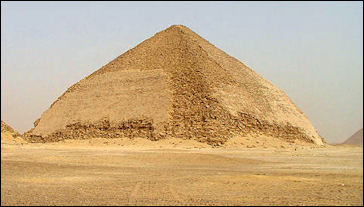
Bent pyramid The Egyptian believed that any mound or pyramid was a symbol of life. Atum, the god of creation, emerging on a mound from the waters of chaos to create mankind and the universe. Pyramids may have represented rays of the sun, on which the pharaohs could ascend to heaven. "The pyramid itself is an enormous machine," one scholar said, "that helps the king go through the wall of the dead, achieve resurrection, and live forever in the happiness of the gods.”
"Few great advances in human technique have been so sudden and spectacular," historian Daniel Boorstin wrote. "Not until the modern skyscraper in the mid-nineteenth century, four thousand years later, was there another comparable leap in man's ability to make his structures rise above the earth."
To put pyramid building in perspective physicists Kurt Mendelssohn wrote: "There is only one project in the world today which, as far as one can see, offers the possibility of being large enough and useless enough to qualify eventually for the new pyramid. And that is the exploration of outer space...In the end, the results of space exploration are likely to be as ephemeral as the pharaoh accompanying the sun. The effort will be gigantic. No other incentive will be provided that the satisfaction of man to make a name for himself by building a tower that reaches into planetary space. Five thousand years ago the Egyptians, for an equally vague reason, accepted a monstrous sacrifice of sweat and toil.”
Before the Pyramids
Before the pyramids, the monuments the Egyptians built for themselves were fortresslike facilities enclosed by mud-brick walls. It is presumed that inside the mortuary complexes where people gathered to honor their departed rule, but because of a dearth of inscriptions related to them archaeologists don’t know much about them. David O’Conner, an Egyptologist at the Institute of Fine Arts at New York University, has found eight such enclosures at Aybdos and believes there are at least a couple more out there waiting to be discovered. [Source: John Noble Wilford, New York Times, January 2007]
Mounds of crumbled mud brick are all that remain of these structures today. In recent years an effort has been made to restore and rebuild one of them — Shunet el-Zebib in Abydos. Built for King Khasekhhemwy, who ruled in the second dynasty around 2780 B.C., it was the last and largest of the cult buildings and the only major one still standing in a clearly recognizable form. Located on the desert plain in Abydos, it covers roughly one hectare and embraces walls that were 11 meters tall and five meters thick. In one enclosure remains were found of benches for statues and inscribed tablets as well as evidence of spilled libations and burnt incense.
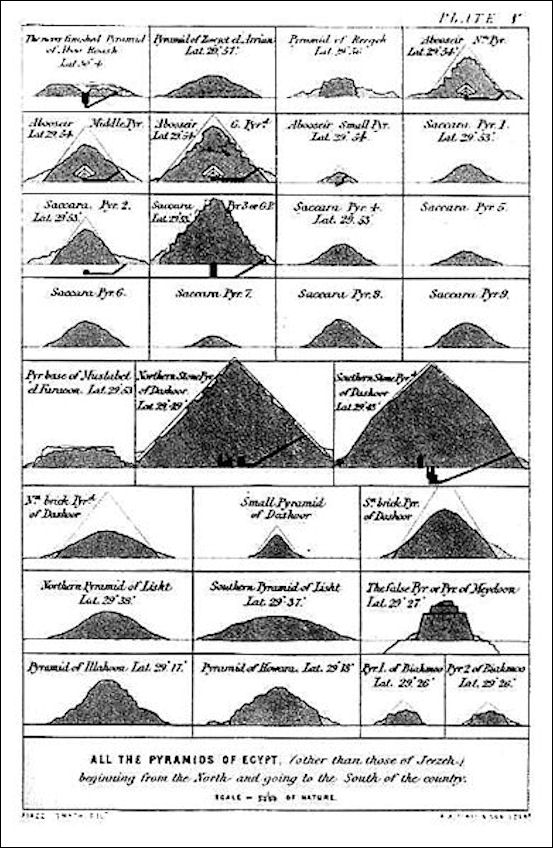
John Noble Wilford wrote in the New York Times, “At Shunet el-Zebin, the pre-pyramid architecture represents a grandeur of purpose and investment of time and labor signifying expanding royal power. High, thick double walls, more massive than that for any previous mortuary complex, enclose a rectangular open space. Originally the structure had four monumental gates and a whitewashed facade that glistened in the sun...The open area in the center could accommodate a multitude of people, though archaeologists are not sure if the public was allowed inside. Traces of small chapels have been uncovered inside the walls. Each was dedicated to a specific king.” Rulers were not buried at the sites. The underground royal tombs are about 1.5 kilometers south of the excavated enclosures.”
Writing in the “The Oxford History of Ancient Egypt”, Kaythrn Bard, an Egyptologist at Boston University, wrote: “The paramount role of the king is certainly expressed in these monuments, and the symbols of the royal mortuary cult which evolved at Abydos were to become further elaborated in the pyramid complexes” of later dynasties.
Imhotep, the Pyramid Architect
The ancient Egyptian architect Imhotep was the master mind behind the pyramids. In addition to being an architect and designing the first pyramid — which has lasted until today — he was a sculptor, poet priest, government official, astrologer, magician and a healer. One ancient inscription even gave Imhotep credit for saving his country from famine by convincing Khnum, the god of the first cataract, to let the floods return. After his death, Imhotep was worshiped as a god of wisdom. Small statues often show him as a learned man holding a papyrus scroll.
According to Minnesota State University, Mankato: Imhotep “was born a commoner during the Third Dynasty. He was very skilled and was dedicated to the ideals of his nation. Imhotep quickly rose through the ranks of the temple and court to become a vizier and the High Priest of Ptah. [Source: Minnesota State University, Mankato, ethanholman.com +]
“He wrote many medical and didactic texts. He is best known, however, as the chief architect of the step pyramid at Saqqara. It remains today as one of the most brilliant architecture wonders of the ancient world. During the New Kingdom, Imhotep was deified and became the "Son of Ptah." The Romans Claudius and Tiberius inscribed their praises of Imhotep in the temples in Egypt. +\
Step Pyramids in Ancient Egypt
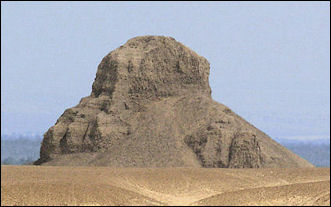
Black Pyramid of Amenemhet III The first pyramid built that remains standing today is the Step Pyramid of Djoser built in 2700 B.C. It is regarded as the world’s first big stone building. Before this time the Egyptians burned their dead in brick structures called “ mastabas” . Step pyramids were designed to be a “staircases to heaven.” They were "not the symbol of a ladder but an actual one, by which the soul of the dead ruler might climb to the sky, joining the gods in immortality.”
The basketball- to oven-size stones used to make this pyramid were quarried several miles away from the pyramid site at a limestone cliff, called Tura, on the other side of the Nile. Tura was the name of the quarry where much of the stone used to build the pyramids was quarried and the limestone that was quarried there. Tufa limestone was transported 400 miles down river to Aswan where it was used for a pharaoh's burial chamber.
The stones of the pyramids were not cemented together; they relied on the angle of incline for stability. We are not exactly sure what the interior of step pyramids looked like. The disintegrated pyramid of Meidum near Memphis was a step pyramid with a core covered with six layers of Tura limestone blocks.
Saqqara (20 miles south of Cairo) is the home of ancient Egypt's oldest cemetery and was a religious center for the ancient capital of Memphis. Built on top of plateau that overlooks Memphis, it is famous for its mastabas (tombs) and step pyramids (the oldest large building in the world). Most of the buildings were built between 3,100 and 2181 B.C. The most famous of these is the Step Pyramid of Djoser, built in Third Dynasty of Old Kingdom for a pharaoh named Djoser (Djoser). It is possible to ride by camel from the Great Pyramids of Giza to Saqqara. This route passes by the pyramids of Abu Sir and Abu Gaurab that are otherwise difficult to reach.
Saqqara sits on the top or a barren, rocky escarpment above the green Nile Valley. It was established as a burial ground for Memphis. The cemetery area was huge. It stretched for 45 miles along the Nile. Many of the tombs are mastabas, which have been built above the ground. There was an entire cemetery devoted to mummified cats.
Step Pyramid of Djoser

Step Pyramid Saqqara Step Pyramid of Djoser (Djoser) was built in 2700 B.C., making it the oldest pyramid in Egypt and perhaps "the world's first construction project." Made primarily of stones about nine inches square, the step pyramid is roughly the same size as the smallest of the three main pyramid at Giza and is the oldest known stone building of its size. Comparable-size buildings in Mesopotamia were made of mud bricks.
The Step Pyramid of Djoser is comprised of six terraced levels — four built above ground, and two larger ones added later by excavating the ground underneath the original four. The pyramid is 200-feet-high and has a rectangular base that measures 597 feet from north to south and 304 feet from east to west. It was larger when it was built but weather and scavengers taking blocks have reduced its size.
A wall buttressed with reedlike columns, surrounds the step pyramid complex. Located on the south side of wall is an entrance colonnade and thirteen false entrances (immovable doors with great hinges) through which it is said the pharaoh's spirits could pass. There are also several false temples, which are filled with rubble instead of tombs. These false temples were constructed for similar reasons as the paper money and cardboard microwave ovens and motorcycles burned at Chinese funerals today. "They worked in the afterlife," said one archeologist, "precisely because they could not work in this one."
Archeologists believe it took hundreds of men about 35 years to build the step pyramid and the structures around it. Between the false entrances and the pyramid there is a large courtyard. A smaller ceremonial courtyard is situated in front of the deity chapels on the east side. There are also ruins of a Funerary Temple, other courtyards, an entrance hall, and a small temple. Mastabas (tombs) of lesser rulers surround the step pyramid, and the pyramid itself is believed to have been built on top of a mastaba built earlier. The tomb of the king is in a shaft below the pyramid.
The stones for the Saqqara pyramid was quarried several miles away on the other side of the Nile from a limestone cliff at Tufa. Ships carried the stone to the banks of the Nile, where a work force of men hauled the stones on sledges, lubricated with oil, to the building site where "master carvers shaped each block and put it in place.” Nearby is a ruined pyramid built by Pepi II, in 2250 B.C. It was originally 172 feet high, but now it is rubble. Altogether there are 13 pyramids in Saqqara, all of them older and smaller than the ones at Giza. Most are ruins.
Other Early Pyramids
.jpg)
Bent Pyramid of Dashoor Pyramid of Unas is located to the south of the Step Pyramid of Djoser. Built by the last of the Dynasty V pharaohs, it is noted for its tomb chamber, whose walls are inscribed with what is now known as the "Pyramid Texts" — an important ancient Egyptian text and the earliest known example of decorative tomb painting. The ceiling in the chamber is decorated with stars for royal mummy to look at. Next to this pyramid is the Persian Shafts, a series of 80-foot-deep tomb chambers with colorful wall paintings. The Tomb of to at Saqqara features a painted limestone relief of to watching a hippopotamus hunt and cattle being forded across a river.
The Pyramid of Pepi I contains the most complete set of tomb texts in Egypt. Dating to 2300 B.C., they took 20 years to reassemble. In the tombs of Princess Idut, Maya and Teti there is evidence of images being erased and replaced with new images, which some scholars believe to be evidence of murder.
Maidum (40 miles south of Giza) contains the now-ruined Snefru pyramid. This step pyramid once was 306 feet high and is regarded as link between step pyramids and the pyramids. The steps created a 51̊ angle of incline, the same as the pyramids at Giza. The Snefru pyramid mostly like collapsed before it was finished. Others believed it was completed and its stones were used to make Greco-Roman structures at a nearby oasis.
Snefru's Pyramid, Bent Pyramid and Red Pyramid
Dahshour (15 miles south of Cairo, west of the town of Dahshour) is a two mile long area in the southern part of the necropolis of Memphis. For many years this was a military area and tourists needed a special permission to visit it. In 1996, a group of five large pyramids, second in size on to the Pyramids of Giza, at Dahshour where opened to the public. The pyramids at Dahshour are among the world's oldest. In addition to Snefru's Pyramid, Bent Pyramid, and Red Pyramid, the site also contains gray granite remains of a forth pyramid and the white limestone dust of a fifth.
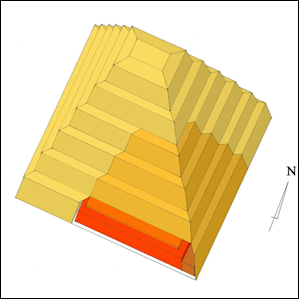
Step Pyramid of Djoser Snefru's Pyramid (at Dahshour) is one three pyramids built in 2600 B.C. to honor the pharaoh Snefru, the father of Cheops, the builder of the largest pyramid in Giza. Two of Snefru’s pyramids are in Dahshur. The original cedar beams from Lebanon can still be seen in one of them. One pyramid referred to as Snefru's Pyramid is located on the edge of lush irrigated land. It is 341 feet height and is much broader than the pyramids built later at Giza. The tomb was looted 4,500 years ago and a wooden wedge used by the thieves to pry open the three-and-a-half ton granite sarcophagus lid is still in place. One archeologist called it "an inside job" because the "robbers knew exactly how to get in here."
Bent Pyramid (at Dahshour) is the nickname of the other Dahshour pyramid, which has a rhomboidal shape. Built for Snefru, it is 344 feet high and measures 620 feet at the base. The top half of the pyramid inclines at an angle of 43̊ while the bottom half slopes at 54̊. No one has convincingly provided an explanation for the pyramid's shape. The angle was changed, some scholars believe, in the middle of construct to keep it from crumbling like the third, now-ruined Snefru pyramid in Maidum. It once was a 306-foot-high step pyramid with 51̊ angle of incline, the same as the pyramids at Giza. Others believe than angle was changed after the base began sinking in clay and cracked and forced the angles of the sides to be changed. The Bent Pyramid has two entrances and most of the original outer stones are still in place. Inside are cedarwood beams imported from Lebanon that are still in relatively good condition after more than 4,000 years.
Red Pyramid (at Dahshour, north of the Bent Pyramid) get its color from the iron in underlying blocks of local limestone now exposed. The scholar Daniel Boorstin wrote it "was the earliest tomb known to have been completed as a true pyramid. It seems flat compared with the larger pyramids in the Giza group...The builders cautiously inclined this pyramid at an angle (43 degrees and 26 minutes) almost the same as the upper half of the bent Pyramid. Their caution was justified, for the basic structure has withstood the millennia. But the gentle slope made it easy quarry for stone robbers. Piece by piece over the centuries they removed the original covering of dressed white limestone, which once gave it a dazzling elegance, leaving it now with a distinctive color never intended by the architects."
Pyramids of Giza
The Pyramids of Giza are the only one of Seven Wonders of the World that survive today. They are huge mausoleums built for three pharaohs in the Old Kingdom — Cheops (father), Chephren (son) and Mycerinus (grandson) — and they once contained the pharaohs mummies. Of the three pyramids Cheops is the largest, Chephren is the second largest, and Mycerinus is considerably smaller than the other two. There are also some small pyramids and some tombs around the main pyramids.
The pyramids are believed to be monuments to the pharaohs’ life force as well as memorials to their lives. Their construction coincided with the development of sun worship in Egypt and its no surprise then that the sun strikes the tops of the pyramids long before it illuminates the dwellings below it. The pyramids may have represented the rays of the sun that the pharaohs used to climb into the heavens.
The Pyramids of Giza are man-made mountains of hewn stone. They are steeper than the pyramids built before them in Saqqara and Danshur because, wrote the scholar Daniel Boorstin, "the pyramid builders had now learned to increase stability by laying the stones of the inner limestone base at a slope...The exact quality of hewn stones inside remains one of the many mysteries. [The] outer structure of huge limestone blocks rests on an inner core of rocks."
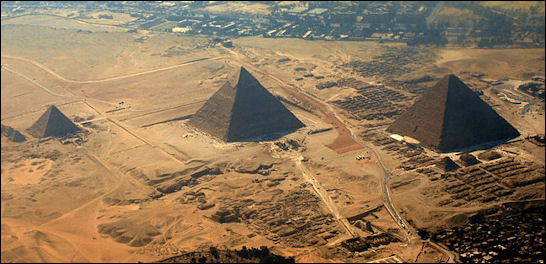
Giza complex from a plane
Each pyramid was the focal point of a complex of subsidiary tombs and temples. A high boundary wall surrounded each complex. Only ritually clean priests and officials were allowed to enter. Access from the Nile was provided by a valley temple constructed at the edge of the river plain. During the funeral of a pharaoh buried in Giza, the funeral boat arrived via the river and was carried up a walled causeway to the mortuary temple at the base of the Pyramids, where the body was entombed.
The Pyramids are awe-inspiring for the size and shape and in imagining the labor involved in building them. Some of the best views of the Pyramids and the Sphinx are from barren hills around the plateau. It easy to reach these hills by foot or on the back of a camel or horse. All kinds of organisms live in the Pyramids. They include some foxes living near the top.
Giza
Giza (6 miles to the west of central Cairo) was the religious center of the IV dynasty rulers of the Old Kingdom which ruled over Egypt between 2650 and 2450 B.C. The Great Pyramids and the Sphinx are located here as well as Egypt’s oldest hypostyle hall, some of the world’s oldest paved streets, the oldest faience works, causeways, walls, corridors, Old Kingdom tombs of priests, aristocrats and commoners, and an entire city for 20,000 or so pyramid-builders that includes the remains of bread bakeries, breweries, shops, and copper works.
The Giza Plateau is limestone escarpment that abuts the west bank of the Nile and sits at an elevation of about 350 feet higher than its surroundings. The view in some directions has not changed since ancient times. As you gaze westward all there is is sand and stone all the way to Libya. Turn around and see Cairo’s sprawl.
According to PBS: Giza "is more than just three pyramids and the Sphinx. Each pyramid has a mortuary temple and a valley temple linked by long causeways that were roofed and walled. Alongside Khufu and Khafre's pyramids were large boat-shaped pits and buried boats that were presumably meant to aid the pharaoh's journey to the afterlife. As yet, no vessels have been found beside Menkaure's tomb. In addition, cemeteries of royal attendants and relatives surround the three pyramids. The entire plateau is dotted with these tombs, called mastabas, which were built in rectangular bench-like shapes above deep burial shafts." [Source: PBS]
The pyramids are usually dated to 2550 and 2470 B.C. based on the Kings Lists. But these dates are of some dispute. Carbon 14 dating of organic materials found in the mortar of pyramids reveals dates that on average are 374 years older than the dated derived from the Kings List. Dating of the Great Pyramid based on fact it was once aligned with the northern alignment of two stars — Kochab in the Little Dipper and Mizar in the Big Dipper — but is slightly off this alignment today because of wobbles in earth’s rotation make it 75 years older than Kings List date.
Whether or not the Pyramids were aligned using the aforementioned stars is still matter of debate. In any case, in the time of the Egyptians, they were not aligned with Polaris, our current North Star. The wobble described above was created by the gravitational pulls of the sun and the moon and trace a small circle in the sky every 28,500 years or so. Over time the North Pole points to different stars, In about 8,000 years Deneb will be the North Star.
.svg.png)
Giza pyramid complex
Layout of the Giza Pyramid Area
Richard Bussmman of University College London wrote: :The Khufu cemetery at Giza has sparked wide interest in the research literature due to its planned layout. The pyramid of the king lies at the heart of the cemetery and is accompanied by the ancillary pyramids of the queens. The princes are buried in large mastabas in the Eastern Cemetery, other court officials in medium sized mastabas in the Western Cemetery. Both Eastern and Western Cemetery were originally laid out on a checkerboard, later populated with other tombs in a less rigid fashion. [Source: Richard Bussmman, University College London, UCLA Encyclopedia of Egyptology, 2015, escholarship.org ]
“The distinctive arrangement at Giza has clear forerunners at Maidum and Dahshur but differs from the early dynastic royal cemeteries. At Abydos, the royal tombs are surrounded by subsidiary burials, each of almost identical size. The same template is used by other high-ranking contemporaries and their courts, buried at Naqada, Tarkhan, Saqqara, Giza, and Abu Rawash. In contrast, there is only one court cemetery in the 4th Dynasty. Tomb types and sizes reflect a nuanced hierarchy of an interdependent court community, cascading down from kings to queens, and from princes to mid- ranking courtiers. The change of the spatiallayout and the different geographical distribution patterns of court cemeteries mirror two interrelated processes during the 1st to 4th Dynasty: centralization and stratification of the core elite.
“An interesting corollary is the stronger emphasis on the royal family as opposed to the king alone. This indicates perhaps the birth of a dynastic principle based on father-son succession. It is probably no coincidence that the royal title “son of Ra” is first attested for Radjedef and the title “son of the king” is typical of the highest court officials in the early to mid-4th Dynasty. Both titles suggest that the father-son model was explored more widely for the display of status and legitimacy in the 4th Dynasty than it was before.
“Practice may well have been at variance with ideology. Kings may not have been the sons of deceased predecessors, the Eastern Cemetery at Giza was probably not used by “true” princes only, and the hierarchy of tombs must not be conflated with real power relationships at court. In other words, cemetery organization reflects an imagined model of court society, which takes a new distinct shape in the early 4th Dynasty.”
Building the Giza Pyramids
The pyramids of Giza are made from granite blocks, weighing as much as 70 tons, and limestone blocks, weighing up to 15 tons. The stones were mined on the other side of the Nile from the pyramids and transported to the pyramids by boat and sledge. In terms of how such large stones were put in place there is pretty good evidence ramps made of rubble were constructed around the pyramids and used to transport the blocks to where they were positioned.
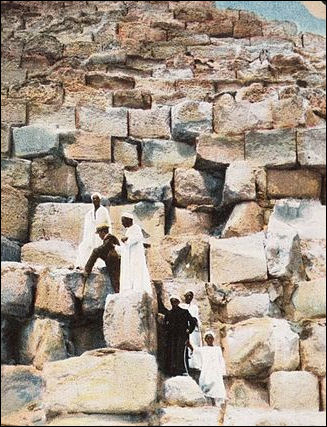 Originally the pyramids were covered by a layer of carefully dressed white limestone casings that were brought from quarries on the east side of the Nile, cut in blocks and laid with exquisitely fine joints and polished. When these stones were in place the surfaces of the pyramid glistened like mirrors in the sun. Over the centuries the casings have been removed (most likely by scavengers getting material for other buildings or to make lime). Some were stripped off by Muslims for the buildings in Cairo. What we see today are the cores of the original pyramids.
The cores of the larger pyramids were made of crudely cut limestone blocks, with the seams between filled with pieces of limestone and blobs of gypsum mortar. Smaller pyramids had cores with small stones, mud or mud brick retaining walls.
Originally the pyramids were covered by a layer of carefully dressed white limestone casings that were brought from quarries on the east side of the Nile, cut in blocks and laid with exquisitely fine joints and polished. When these stones were in place the surfaces of the pyramid glistened like mirrors in the sun. Over the centuries the casings have been removed (most likely by scavengers getting material for other buildings or to make lime). Some were stripped off by Muslims for the buildings in Cairo. What we see today are the cores of the original pyramids.
The cores of the larger pyramids were made of crudely cut limestone blocks, with the seams between filled with pieces of limestone and blobs of gypsum mortar. Smaller pyramids had cores with small stones, mud or mud brick retaining walls.
According to to PBS: “Some Egyptologists believe it took 10 years just to build the ramp that leads from the Nile valley floor to the pyramid, and 20 years to construct the pyramid itself. On average, the over two million blocks of stone used to build Khufu's pyramid weigh 2.5 tons, and the heaviest blocks, used as the ceiling of Khufu's burial chamber, weigh in at an estimated nine tons. Khufu's son, Khafre, who was next in the royal line, commissioned the building of his own pyramid complex which includes the Sphinx. Menkaure, who is believed to be Khafre's son, built the third and smallest of the three pyramids at Giza.
Thousands of laborers were used to build the pyramids. Some historians claim they were slaves forced into working by cruel supervisors. Other historians say the workers were reasonably paid and happy to have a job.
The Nile was once originally about a quarter mile from the pyramids and a temple stood on the shore of the river. A causeway from the temple passed some boats pits, a mortuary temple, an enclosure wall, subsidiary pyramids for the pharaoh's queens and finally led to the great pyramid itself. Today the riverside temple is about a half mile inland. At the base of Cheops are three small temples dedicated to wives or family members of the pharaoh.
Some scientists believe that the limestone blocks are not limestone blocks at all but rather concrete blocks that were formed in place. French scientist who first proposed this theory said Egyptian authorities prevented them from taking the samples to prove their theory. The theory is partly based on the narrowness of the joints between the rocks, which the scientists say is easy to create if the rock is formed but nearly impossible with quarried stones unless milling tools are available. If the theory is true it would end the need to explain how the massive stones were moved. Many think the theory is nonsense.
Great Pyramid of Giza (Pyramid of Cheops, Khufu)
The Great Pyramid of Giza was built in honor of the pharaoh Khufu (reign ca. 2551 B.C.-2528 B.C.) and is the largest of the three pyramids constructed on the Giza plateau in Egypt. Considered a "wonder of the world" by ancient writers, the Great Pyramid was 481 feet (146 meters) tall when it was first constructed. Today it stands 455 feet (138 meters) high. [Source: Owen Jarus, Live Science July 19, 2016]

Inside Cheops Pyramid The Pyramid of Cheops (Khufu) is still one of the largest buildings ever created. The first and the largest of the pyramids at Giza, it is 756 feet square. covers 13 acres at its base and is made of 2.3 million blocks of stones. The stones weigh an average of two and half tons each and collectively weigh 6.25 million tons. The stones fit so well together that even a playing card can not be inserted between them. The structure took 25,000 workers 16 years to build.
The Pyramid of Cheops was built in 2550 B.C. and was the tallest monument in the world for 43 centuries until the Eiffel Tower was built in the 19th century. The base covers twelve and half football fields. It is said that you can fit all the cathedrals of Milan and Florence in the base and still have enough room left for St Paul's and Westminster Abbey of London and St. Peter's in Rome. Walking around the perimeter is equivalent to a walk of 11 city blocks.
The Pyramid of Cheops has an angle of incline of 51 degrees. The squareness of the north and south sides are off by only .09 percent, and the east and west sides by only .03 percent. The paved foundation on which the pyramid sits deviates from a true plane by an amazing .004 percent. Somehow this amazing precision was achieved without only the aid of a capstan, a pulley or even a wheeled vehicles.
The climb to the top of the Pyramid of Cheops takes about a half hour, but visitors are no longer allowed to make the ascent. Most of the stones are fitted so they are waist high. Originally the pyramid was 10 meters taller than it is now but wind and weather have whittled it down in size.
Burial Chamber in the Pyramid of Cheops
The 30-foot-high burial chamber in the Pyramid of Cheops is about halfway between the base and the summit. The 150-foot tunnel leading to the chamber is only four feet high, which means that people that enter it have to bend over to reach the chamber. Inside the King's chamber is a huge granite sarcophagus that is an inch wider than the entrance to prevent its removal. The lid which is slightly smaller than the entrance has been removed. To keep the dead Pharaoh cool the pyramid is even outfit with air vents.
The burial chamber in the Pyramid of Cheops is topped by five granite slabs and a pitched roof to prevent it from being crushed by the weight of the pyramid. Nearby is a chamber of unknown purpose originally thought to have been the queen's chamber. Exiting from both chambers are several narrow shafts that may have been built for the pharaoh's spirit to come and go.
The chamber was sealed from within by workers who exited through a tunnel that led to a subterranean shaft. Underneath the base is a chamber carved out of bedrock that may have been the original royal burial site. In spite of hidden entrances, granite plugs and walled-off passages, built in part to foil thieves, the pharaohs treasures were looted, most likely by fellow ancient Egyptians.
Visitors are allowed to climb inside the Pyramid of Cheops to the funerary chamber in the middle. The main entrance to the tomb, a tunnel excavated by ancient grave robbers, leads to an ascending corridor and a grand gallery, off of which is the king's burial chamber. Only 300 people are allowed inside the tunnel and chamber each day: One hundred-fifty tickets go on sale at 8:00am and another 150 go on sale at 1:30pm. Even with this system there are lines outside the entrance of the pyramid waiting to get inside.
Pyramids of Chephren and Mycerinus
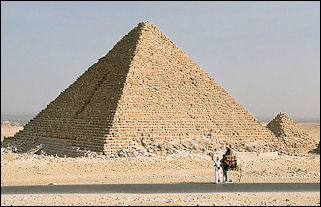
Mycerinus pyramid The Pyramid of Chephren (southeast of the Pyramid of Cheops) is the second largest pyramid by only a few feet. Built in 2520 B.C. with roughly the same structure and layout as Cheops, it is 471 feet high, 690 feet square and has an angle of incline of 53̊. The top of this pyramid is covered by limestone blocks, which originally covered the entire structure. There are two entrances on the north side. Chepren (also spelled Khepren and known as Khafre) was the son of Cheops. His burial chamber, like that of the Pyramid of Cheops, is at the center of the pyramid.
Dr Aidan Dodson wrote for the BBC: “After Khufu's death, he was succeeded by his son, Djedefre, who built his own pyramid about four miles to the north, at Abu Rowash. He made no attempt to match his father's monument for size-its area is less than a quarter that of the Great Pyramid-but instead built it atop a towering cliff. |Djedefre's obscure probable successor, on the other hand, began another giant pyramid, 200m (650ft) square, south of Giza at Zawiyet el-Aryan. This never got as far as the foundations, but another son of Khufu, Khaefre, built the last of the truly gigantic pyramids, back at Giza. His 215m (705ft) square 'Second' pyramid was then followed by Menkaura's 'Third' pyramid, only half the size. Later generations settled for even smaller examples-although with much larger and more lavishly decorated temples: the era of the giants had passed. [Source: Dr Aidan Dodson, BBC, February 17, 2011]
The Pyramid of Mycerinus is the smallest of the three main Giza pyramids. It is only about 190 feet high — less than half of the height of the other two — and considerably smaller in size. Built in 2470 B.C, it is distinguished by the fact that the lower part of its sides still retain their granite slab covering. The causeway to this pyramid passes by the great wall which separated the workers village and overseer tombs from the pyramid complex. The three pyramids are surrounded by several small pyramids, and hundreds of mastaba-tombs of the royal family members, nobles and high ranking people. The largest single block in a pyramid is a 320-ton stone in the Pyramid of Mycerinus (Menkaure).
The tunnel and burial chamber at Chephren underwent a $294,000, 10-month restoration in the late 1990s after a chunk of limestone fell from the ceiling of the burial chamber. A ventilationsystem was installed and the chamber was reopened to tourists. Nearby visitors can also see the remains of a valley temple and mortuary temple where the body of the pharaoh was embalmed. Its causeway passes near the sphinx.
Pyramids for Royal Women and Royal Tombs at Giza
The Pyramids for Royal Women(at the Pyramids of Giza Site) were opened to the public for the first time in 1998 after a seven year restoration. Considerably smaller than the great Pyramids at Giza and located near the Pyramid of Cheops, they were built by Cheops to entomb his mother, Metepheres, and two wives, Henutsen and Meryetes. The tallest of the three, for Metepheres, is only 34 feet high. The smallest, for Henutsen, is less than 19 feet high. The mummies that are believed to have been in them have never been found.
The Pyramids for Royal Women are not very impressive. They are short and squat and have oversized bases. Each is made from the about two tons of limestone bricks (the rest of structure is fill) and includes a burial chamber that is reached by a corridor that leads downward from the entrance. The burial chamber can be visited. There isn't much to see. Some of the objects found in Metoheres tomb — scarabs, chairs, beds, jars, vessels — are here.
Royal Tombs Giza (at the Pyramids of Giza Site) can be found on the front and back sides of the Pyramids of Giza site. Most of the tombs are square, room-size structures made from blocks of stone. They are notable in that they feature well-preserved engravings that date back before 2500 B.C.
Osiris Tomb (100 meters down the causeway that connected Khafre’s Pyramid and the Sphinx) honors the God of the Dead. Carved out of stone in the 7th century B.C., it extends to 100 feet below the Giza plateau and contains six rock-cut brurial chambers 50 feet below the surface. Inside the burial chamber at the bottom are four ereoded pillars, a granite sarcophagus and lots of water. The tomb is currently only open to archeologist that have special permission to visit it.

Pyramids of Senusret III in Dahshur: Middle Kingdom Pyramids
Dieter Arnold of the Metropolitan Museum of Art wrote : “The pyramid field of Dahshur is located along the western desert edge, 30 kilometers south of Cairo. The site includes two huge stone pyramids built by the Dynasty 4 king Snefru and three smaller Dynasty 12 brick pyramids that belonged to Amenemhat II, Senusret III, and Amenemhat III. The five pyramids are separated by vast areas of desert that contain private mastaba tombs and burials, stone quarries, pyramid construction ramps, causeways, workers' settlements, and other installations. [Source: Arnold, Dieter. "The Pyramid Complex of Senusret III in the Cemeteries of Dahshur", Heilbrunn Timeline of Art History, New York: The Metropolitan Museum of Art, October 2004, metmuseum.org \^/]
“Amenemhet II's son, Senusret, became co-regent with him during the last three years of his reign. He built his pyramid in Dahshur, to the east of the 4th Dynasty pyramids. “King Senusret III (r. 1878–1840 B.C.) was one of the most powerful and important rulers of ancient Egypt. Key developments in religion, political administration, and the arts took place during his reign. He built two funerary complexes, one in Abydos and the other at the north end of the Dahshur pyramid field. Unlike Old Kingdom pyramids, which were constructed entirely of stone, Senusret III's pyramid had a mud-brick core cased with limestone. In ancient times, the valuable limestone was removed by robbers, revealing the soft brick core. As a result of long exposure, the pyramid has now deteriorated to a 21-meter-high mound with a deep crater in the center; originally the pyramid was 62 meters high.\^/ “The Dahshur complex was constructed in two phases. The original complex, which more closely followed Old Kingdom prototypes, included the pyramid, a small pyramid temple to the east, and a stone inner enclosure wall. A second, outer enclosure wall made of brick surrounded six smaller pyramids built for the royal women and a seventh pyramid that served as the king's subsidiary or ka pyramid. Later in the reign of Senusret III, the pyramid complex was enlarged to the north and south, transforming the originally square ground plan into an elongated rectangle. The larger southern extension contained the huge South Temple that seems to have marked the appearance of a new building type in a royal pyramid complex, perhaps replacing or broadening the function of the traditional pyramid temple. \^/
“The plan of Senusret III's apartments under the pyramid closely follows those built by the kings of late Dynasty 5 and Dynasty 6. Senusret III's construction had a long entrance passage, antechamber, crypt, and a room to the side of the antechamber called a serdab by Egyptologists. An unusual feature is the placement of the pyramid entrance, which was not positioned in the north, as was traditional, but in the west. The walls of Senusret III's burial chambers were lined with beautifully finished white limestone, while the crypt was constructed of red granite that was whitewashed. Unlike some Old Kingdom pyramids, the walls were not inscribed with pyramid texts. The crypt contains a finely carved red granite sarcophagus embellished at the base with a pattern that replicates the form of an enclosure wall with palace facade paneling. The absence of any human remains in the tomb, as well as the cleanliness of the interior of the sarcophagus, suggests that Senusret III was not buried in his tomb at Dahshur; instead, the king may have been interred in Abydos, where the king built another mortuary complex. \^/
“The king's pyramid, the burial places of the royal women, and the private tombs surrounding the pyramid complex were plundered during the unstable period of Hyksos rule (ca. 1600 B.C.). The main destruction of the area occurred in the later Ramesside Period (ca. 1295–1186 B.C.), when the pyramids and mastabas were quarried down to their foundations. From the Late Period (712–332 B.C.) onward, the ruined site was used for lower-and middle-class private burials; most of the tombs belong to the late Roman period (ca. 200–350), though Christian burials have also been uncovered. \^/
“The first large-scale excavation of Senusret III's complex was carried out by the French archaeologist Jacques de Morgan (1857–1924) between 1894 and 1895. The Metropolitan Museum resumed excavation work at the site in 1990 and continues its work in yearly, three-month campaigns.” \^/
Books: Arnold, Dieter The Pyramid Complex of Senusret III at Dahshur: Architectural Studies. With contributions and an appendix by Adela Oppenheim and contributions by James P. Allen. Publications of The Metropolitan Museum of Art Egyptian Expedition, vol. 26.. New York: n/a, 2002.
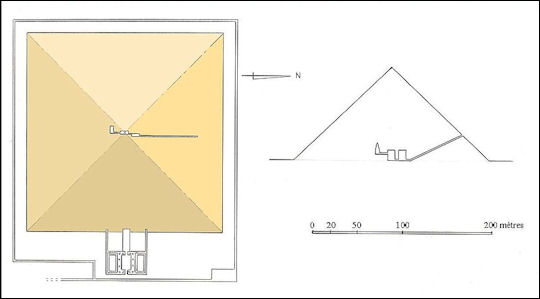
Red Pyramid plans
Pyramids of the Queens and Princesses of Senusret III
Adela Oppenheim of the Metropolitan Museum of Art wrote: “Flanking the pyramid of Senusret III on the north and south were seven smaller pyramids that primarily belonged to women of the royal family. Beginning with the Dynasty 4 pharaoh Khufu (r. 2551–2528 B.C.), small pyramids for queens and princesses were commonly placed near the pyramid of the king. [Source: Adela Oppenheim, Department of Egyptian Art, The Metropolitan Museum of Art, October 2004, metmuseum.org\^/]
“The three pyramids to the south of Senusret III's pyramid are earlier and larger than those to the north. The easternmost pyramid of this group probably did not belong to a royal woman, but rather was intended to house the ka, a part of the king's spirit that played an important role in his afterlife. The center pyramid on the south belonged to a Queen Weret I. Inscriptions found around her pyramid, and also at other monuments in Egypt, tell us that she was the mother of a king, presumably Senusret III. No burial chamber was discovered under or near Queen Weret I's pyramid, leading to the conclusion that she was interred elsewhere, perhaps at Lahun near the Faiyum oasis with her presumed husband Senusret II. In this case, Queen Weret I's pyramid at Dahshur would have served as a cenotaph or memorial. The queen mother seems to have played an important role in the king's afterlife. \^/
“The westernmost pyramid on the south side belonged to Queen Weret II, the principal wife of Senusret III. Although her tomb was plundered in antiquity, its entrance remained hidden under the desert sands for centuries until the entrance shaft was found by the Metropolitan Museum excavation in 1994. Queen Weret II's elaborate underground burial complex consists of a shrinelike construction placed under her pyramid and elaborate burial chambers that were actually built beneath the pyramid of the king; the two spaces are connected by a long corridor. Several small objects and pottery that escaped the attention of the tomb robbers were found in her burial chambers. Most surprising was the rare discovery of a cache of the queen's jewelry in a niche at the bottom of the entrance shaft; the unusual placement of the deposit probably led to its being overlooked by the tomb robbers. The objects include two amethyst scarabs inscribed for the pharaoh Amenemhat II, two bracelets with djed-pillar clasps signifying stability, two bracelets with gold lion pendants, a girdle composed of gold cowrie shells, and two anklets with claw pendants. The pieces, now on display in the Egyptian Museum, Cairo, represent the sixth major find of royal Middle Kingdom jewelry. On display in the Metropolitan Museum is another jewelry collection that belonged to the Dynasty 12 princess Sit-Hathor-yunet; this group of objects was excavated by the British at Lahun. \^/
“North of Senusret III's pyramid are four smaller pyramids, built later in the king's reign. The second and third from the east belonged respectively to Princess Itakayet and Queen Nefrethenut; the owners of the other two pyramids remain unknown. Burial chambers with stone sarcophagi were placed beneath each of the four pyramids. To the east of the easternmost pyramid, eight royal women were buried in small chambers hollowed out on either side of a common corridor. In this area, Jacques de Morgan (1857–1924) discovered two caches of jewelry on two successive days in 1894. Both treasures are now displayed in the Egyptian Museum, Cairo. \^/
“All of the pyramids belonging to royal women had small chapels dedicated to the cult of the deceased; the four north pyramids seem to have had only east chapels, while the two queens' pyramids on the south had north and east chapels. Fragments of relief decoration recovered from these structures indicate that the decorative program consisted mainly of standard offering scenes: processions of offering bearers carrying food approached the queen or princess, who was seated in front of a table. In front of the woman was a large list enumerating the type and quantity of goods she could expect to receive in the afterlife. Additional spaces were filled with representations of piled foodstuffs. The area around the door included scenes of men butchering cattle for meat offerings. Inscriptions above the figures of the women, at the tops of the walls, and above the entrance listed their names and titles.” \^/
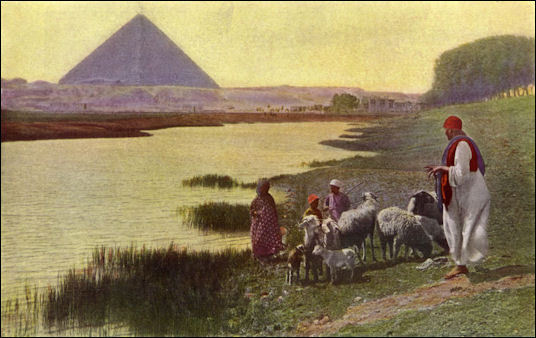
Study of the Pyramids
Dr Ian Shaw of the University of Liverpool wrote for the BBC: “There is still a great deal that remains mysterious about the basic structure of pyramids, and the technology that created them. If we are to gain a better understanding of pyramid-building, the best way seems to be a blend of detailed study of the archaeological remains and various kinds of innovative experimental work. Above all, this is the kind of research that relies on collaboration between Egyptologists and specialists in other disciplines, such as engineering, geology and astronomy. As far as stone masonry is concerned, many volumes have been published describing the surviving remains of pharaonic temples and tombs, whether in the form of traveller's accounts, archaeological reports or architectural histories (Badawy 1954-68, Smith 1958, being the first attempts to provide comprehensive historical surveys). |[Source: Dr Ian Shaw, BBC, February 17, 2011 |::|]
“Between 1880 and 1882, Flinders Petrie, the first truly scientific archaeologist to work in Egypt, undertook some careful survey work on the Giza plateau. This was the site of the pyramid complexes of the rulers Khufu, Khafra and ë-all of whom lived in the Fourth Dynasty....Although there have been many meticulous studies of specific sites or buildings, only a few-notably Petrie's surveys of the pyramids at Giza and Meydum in 1883 and 1892-have focused on the technological aspects of the structures. On the other hand, it is remarkable that, despite Petrie's concern with the minutiae of many aspects of craftwork and tools, his general works include no study of the structural engineering of the Pharaonic period. |::| This gap in the literature began to be filled in the 1920s with Reginald Engelbach's studies of obelisks (Engelbach 1922, 1923), Ludwig Borchardt's many detailed studies of pyramid complexes and sun temples (eg Borchardt 1926, 1928), and the first edition of Alfred Lucas' Ancient Egyptian Materials and Industries (Lucas 1926), which included a substantial section devoted to the scientific study of stone working. |::|
“However, the first real turning point arrived in 1930 with the publication of Ancient Egyptian Masonry, in which Engelbach collaborated with Somers Clarke to produce a detailed technological study of Egyptian construction methods from quarry to building site (Clarke and Engelbach 1930). The meticulous excavations of George Reisner at Giza and elsewhere soon afterwards bore fruit in the form of the publication of The Development of the Egyptian Tomb down to the Accession of Cheops (Reisner 1936), and Reisner's work at Giza was later supplemented by the architectural reconstruction of the Step Pyramid of Djoser at Saqqara by Jean-Philippe Lauer, whose Observations sur les pyramides (Lauer 1960) was also informed by a sense of the fundamental practicalities of ancient stone masonry. |::|
“Both I.E.S. Edwards (1947, 5th ed. 1993) and Rainer Stadelmann (1985) produced general books on Egyptian pyramids which built on the observations of Borchardt, Reisner, Lauer and others, including substantial discussion of the technological problems encountered by Pharaonic builders. |Christopher Eyre (1987) has provided a detailed study of the textual and visual evidence for the organization of labour in the Old and New Kingdoms, which includes a great deal of data relating to quarrying and building (particularly covering such questions as the composition, management and remuneration of the workforce involved in procuring, transporting and working stone, as well as the timing of quarrying and construction projects). |::|
“Most recently, Dieter Arnold's Building in Egypt: Pharaonic Stone Masonry, published in 1991, is a wide-ranging study of the data, including meticulous discussion of the surviving evidence for quarrying and stone-working tools, and sophisticated, well-illustrated studies of the grooves and marks on stone blocks which can indicate many of the ways in which they were transported, manoeuvred into position and interlocked with the rest of the masonry. Like Clarke and Engelbach's Ancient Egyptian Masonry, it serves as an essential and welcome basis for all future study of Pharaonic stone masonry. Arnold's primary concern is with the technology rather than the materials; for a detailed discussion of the different types of stone utilised by the Egyptians in art and architecture, see De Putter and Karlshausen (1992).
Contextual Approach to the Study of Pyramids
Richard Bussmman of University College London wrote: The “contextual approach” embeds pyramids in their wider natural and organizational environment. At Giza, the area south of the pyramid plateau was the focus of construction activities. The massive Heit el-Ghurab, the “Wall of the Crow,” held back material washed down from the plateau and served to control access to the pyramid field. Walking south, a gate led to a settlement laid out as a series of oblong mud-brick galleries, probably used as temporary dormitories. Bakeries and cattle, imported perhaps from sites in the Delta, served the needs of the workmen who erected additional buildings from stone rubble for living and sheltering. Hundreds of seal impressions suggest that the adjacent area to the south was an administrative center that controlled the stream of people, goods, and activities. The seal inscriptions mention the names of Khafra and Menkaura, and the pottery confirms that the site was used predominantly in the mid to late 4th Dynasty. [Source: Richard Bussmman, University College London, UCLA Encyclopedia of Egyptology, 2015, escholarship.org ]
“South of the Menkaura pyramid, Kromer found the dump of a settlement, originally perhaps comparable to the settlement excavated by Lehner. The seal impressions date to Khufu and Khafra, and the pottery can be paralleled with other early 4th Dynasty material. Nearby, a series of workshops, open courts, and an administrative building were located around what seems to be an S-shaped ramp.
“Excavations at Dahshur demonstrate that social and technological organization on a large scale was already in place a generation earlier. A large open court halfway between cultivation and the Red Pyramid and a temporary workmen camp to the south formed part of the construction activities. One section within the valley temple of the Bent Pyramid was converted into living space during the later Old Kingdom, perhaps for accommodating the royal funerary priests on duty. “Pyramid towns” are well known from titles since the early 4th Dynasty, but are archaeologically still elusive. They may have housed administrators, skilled workmen, and those recruited for the royal funerary cult. A decree of Pepy I indicates that the pyramid towns of Dahshur were located near the valley temple of the Red Pyramid where a large enclosure wall was found.
“The “contextual approach” shows that pyramids are part of a dynamic landscape. Many settlements and workshops are short- lived, reflecting constant change. Large-scale planning is evident from sites such as the Giza galleries and, presumably, pyramid towns. At the same time, the wide range of secondary buildings at all sites hints at a substantial degree of management on a local level, necessary to realize insufficient master plans of the central government.”
Pyramids and Pseudoscience
Over the centuries scholar and psuedoscholars have suggested that maybe the pyramids were giants granaries built before the Great Flood or storehouses of secrets about astronomy and technology built by aliens for the benefit of mankind.
The Moroccan traveler Ibn Batuta (1304-1377) reported that the Egyptian god Thoth "having ascertained from the appearance of the stars that the deluge would take place, built the pyramids to contain the books of science and knowledge and other matter worth preserving from oblivion and ruin." [Source: Daniel Boorstin, "The Creators"]
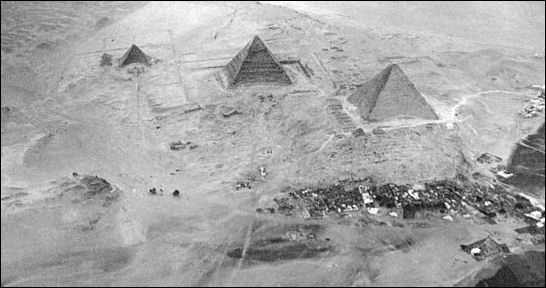
New Agers contend the Sphinx, the Pyramids and other monument were not built by the Egyptians but rather by some superior intelligence, perhaps from another planet. One group, led by the European writers Robert Bauval and Graham Hancock, believes the configuration of the Pyramids matches the position of the stars of Orion's belt as they appeared 10,500 years ago. This they say proves the pyramids were created by an ancient civilization that preceded the Egyptians.
New Agers deluge the Egyptian government with requests to probe sites and pay large sums of money to hold ceremonies when the sites are closed. Egyptians find it annoying that these groups believe the Pyramids were created by beings other than the ancient Egyptians.
Shirley McClaine spent a night mediating inside the Great Pyramid and reported the pyramids were built in 70,000 B.C. and a giant crystal lies buried under the Great Pyramid. In 1998, a German tourist jumped to his death from the Cairo tower in the belief that a trip to the pyramids had made him invulnerable to death.
A Forth Major Pyramid of Giza?
New pyramids are still being discovered. The discovery of the 118th pyramid, dated to around 2300, B.C. , at Saqqara near Cairo, was announced in November 2008. It belonged to Queen Sesheshet, the mother of King Teti, the founder of the 6th dynasty of Egypt’s Old Kingdom.
In 2008, the History Channel aired a documentary called the “The Lost Pyramid” that claimed a new pyramid — built by the Forth Dynasty Pharaoh Djedefre — had been discovered at Giza. Not only that the documentary claimed the new pyramid was nine meters higher that the Great Pyramid of Cheops. Zahi Hawass, Egypt’s premier Egyptologist, said, “I’m a pyramid man, and what I’ve seen now has made me change my view on many things. Every history book in every language is going to be rewritten.”

Comparison of the pyramid of Cheops with other monuments
The only problem with this and other grand statements was that they greatly overstate the reality. The “new pyramid” had been known for more than a century and the main reason it hadn’t been more throughly excavated was because it lay next to a military exclusion zone, where missiles were sometimes tested. The claim that it was higher than the Great Pyramid of Cheops could only be made because it sat on a hill that was half as high as the great pyramid. And on top of that the “new pyramid” isn’t even on the Giza plateau which is eight kilometers to the south and may not even be a pyramid (its slopes are 60 degrees compared to 53 degrees for the pyramids, which some archaeologists say makes it a sun temple). In any case the so called “new pyramid” is hardly impressive. It looks like a collection of ruble and stones.
The producers of the documentary — which also made three King Tut documentaries as well as documentaries for the National Geographic channel — is well-known for rehashing old material on ancient Egypt and calling it new. Other shortcomings of the “new pyramid " include the fact it only has one burial chamber for a a royal bark (the real pyramids have two), no inscriptions for Djedefre have been found, and the true pyramid of Djedefre may be at a different places altogether (a ruined pyramid at Zawyet el-Aryan, south of Giza has a bigger base and Djedefre’s name on it).
Image Sources: Wikimedia Commons, The Louvre, The British Museum, The Egyptian Museum in Cairo
Text Sources: UCLA Encyclopedia of Egyptology, escholarship.org ; Internet Ancient History Sourcebook: Egypt sourcebooks.fordham.edu ; Tour Egypt, Minnesota State University, Mankato, ethanholman.com; Mark Millmore, discoveringegypt.com discoveringegypt.com; Metropolitan Museum of Art, National Geographic, Smithsonian magazine, New York Times, Washington Post, Los Angeles Times, Discover magazine, Times of London, Natural History magazine, Archaeology magazine, The New Yorker, BBC, Encyclopædia Britannica, Time, Newsweek, Wikipedia, Reuters, Associated Press, The Guardian, AFP, Lonely Planet Guides, “World Religions” edited by Geoffrey Parrinder (Facts on File Publications, New York); “History of Warfare” by John Keegan (Vintage Books); “History of Art” by H.W. Janson Prentice Hall, Englewood Cliffs, N.J.), Compton’s Encyclopedia and various books and other publications.
Last updated September 2018
